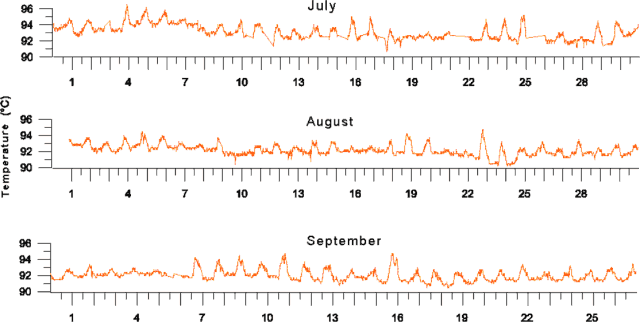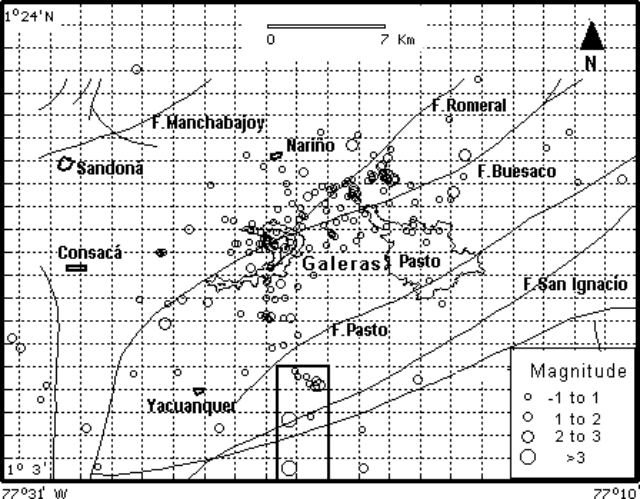Report on Galeras (Colombia) — October 2001
Bulletin of the Global Volcanism Network, vol. 26, no. 10 (October 2001)
Managing Editor: Richard Wunderman.
Galeras (Colombia) Volcano-tectonic earthquakes during July through late September 2001
Please cite this report as:
Global Volcanism Program, 2001. Report on Galeras (Colombia) (Wunderman, R., ed.). Bulletin of the Global Volcanism Network, 26:10. Smithsonian Institution. https://doi.org/10.5479/si.GVP.BGVN200110-351080
Galeras
Colombia
1.22°N, 77.37°W; summit elev. 4276 m
All times are local (unless otherwise noted)
Our last report (BGVN 26:05) discussed the low-level seismicity and eruptive activity observed at Galeras during April 2000-March 2001. During July through late September 2001, the greatest seismic energy contribution (1.7 x 1015 erg) resulted from 70 volcano-tectonic earthquakes. Epicenters were concentrated S and NE of the volcano, and some were felt by local residents. The largest VT events, an M 3 on 22 August (6 km depth) and an M 2 on 13 September (8 km depth), were felt in Pasto and Jenoy.
On 30 September, an M 4 tectonic earthquake centered ~12-18 km S of the volcano was felt in Pasto and some towns toward Nariño, 70 km SE of Galeras. An M 2 aftershock registered seven hours later. It was also felt in Pasto and some towns near the epicentral zone (figure 96).
On 24 August, a gas emission produced a spasmodic tremor episode that lasted ~5 minutes, followed by some long-period (LP) events (figure 97). The tremor's dominant frequencies were between 2and 5 Hz. The LP events had frequencies less than 3 Hz. Real-time temperature monitoring of Deformes fumarole (SW of the active crater) showed stability, in the range 92-94°C (figure 98).
 |
Figure 98. Digital temperature logs taken at Deformes fumarole at Galeras during July-September 2001. Courtesy of OVSP. |
Geological Summary. Galeras, a stratovolcano with a large breached caldera located immediately west of the city of Pasto, is one of Colombia's most frequently active volcanoes. The dominantly andesitic complex has been active for more than 1 million years, and two major caldera collapse eruptions took place during the late Pleistocene. Long-term extensive hydrothermal alteration has contributed to large-scale edifice collapse on at least three occasions, producing debris avalanches that swept to the west and left a large open caldera inside which the modern cone has been constructed. Major explosive eruptions since the mid-Holocene have produced widespread tephra deposits and pyroclastic flows that swept all but the southern flanks. A central cone slightly lower than the caldera rim has been the site of numerous small-to-moderate eruptions since the time of the Spanish conquistadors.
Information Contacts: Patricia Ponce, Observatorio Vulcanológico y Sismológico de Pasto (OVSP), INGEOMINAS, Carrera 31, 18-07 Parque Infantil, P.O. Box 1795, Pasto, Colombia (URL: https://www2.sgc.gov.co/volcanes/index.html).



